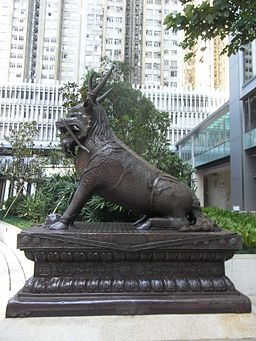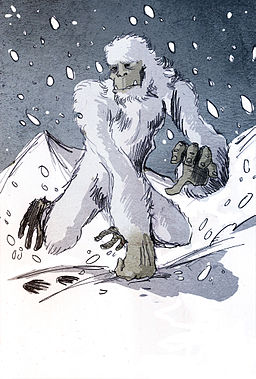For the duration of March, Mondays will play host to monstrous beasts and beings. While we intend to eventually complete a full alphabet for these too, Mam Bach was getting burnout from 6 months of Mythic Mondays, so we’ll be doing it one month at a time.
Zombies
Zombies are everywhere today – books, movie and games, both tabletop and computer – so it might be hard to work out how to give this monster a new and interesting twist in your game and stories. Sometimes the easiest way to make something new is to look to the old:
History
Zombies are in some ways a very new monster, since the version in a lot of people’s’ minds has only been around since the 1960s – but their origins are older than that, with the first written description being from 1816 Brazil.
The term “zombie” has its roots in Voodoo, which is practised mostly in Haiti though it derives from a mixture of African religions crossing with Christianity. In Voodoo a zombie is a dead person who has been revived by a bokor, a Voodoo sorcerer – that person is then under control of the bokor.
Many stories suggest that darker bokor use a somewhat alchemical ritual to make living people into zombies. It usually involves a specially prepared mix of earth, roots and tetrodotoxin (which comes from a pufferfish or related species). If done correctly it can leave someone alive but not in control of their own body.
There is also an astral zombie, a person’s soul that has captured by a bokor to use for magical purposes, this suggests that making someone into a zombie may split their body and soul which may be why the zombie has no free will.
Priestly bokor are rarely said to deal in the physical zombies, but may interact with the astral form, using their aid to heal the wounded and infirm.
So far these zombie are far away from the zombie we know and love today. Indeed, modern zombies are more akin to other forms of undead than to the Voodoo zombie. Many forms of media have been involved in the journey to the zombies we know today.
The earliest zombie apocalypse story might well be “The Day of The Triffids” – a book where sentient plants, which move around in herds, slowly hunt down humans to eat – making a rattling noise to communicate with each other when they find fortified prey. The similarities to modern zombies notably include the requirement that they be decapitated in order to kill them.
The next notable development is in another book “I Am Legend”, they still seem to move around in herds but were only active by night because they were essentially a form of apocalyptic vampires but the main character treats them like they were zombies, thinking them mindless beasts.
Cementing the zombie into popular culture was “Night of The Living Dead”Aided by the fact it became public domain upon release where the creatures have almost all of the archetypical qualities or the modern zombie, though they are called ghouls by a character within the films, with the term zombie coming from the fans and the John Russo series of sequel films – which also introduced the famous hunger for brains.
These are not all the examples but they are major parts of how the myth became what it is today.
History in your Games and Stories
One way you could use the ideas from the Voodoo zombie in your games and stories is the person could be saveable, if their soul (the astral zombie) could be recombined with the physical zombie – which means killing them may become a dilemma for your protagonists, especially if the victim is known to them.
There could also be a cure for the zombie-creating alchemy, needing rare ingredients that the players must quest for. Or there could be a great sorcerer who knows how to reverse the ritual and bring the friend back from the dead but of course you have to go and find this sorcerer first or you may have to do something immoral for the sorcerer to get your friends back.
Drawing instead from “I Am Legend” you could instead choose to have a zombie infection that behaves differently in the living and the dead – with those already dead upon infection being animated as mindless ghouls, but those who were alive remaining somewhat aware and possibly even being able to recover their faculties while remaining zombified.
Physiology
Zombies are usually only humans, though some games and films, such as resident evil have zombie beasts – most often dogs. Still these are rare enough that I’ll be mostly ignoring them for this section.
Zombie are often dead even though they can walk and make noise, but there are many examples where this is not the case, often with a more “scientific” approach to zombies.
One modern example where a living human has been mystically zombified by tetrodotoxin is done well in the TV series Grimm: though the zombified individuals lose willpower they are not innately dangerous – unless something goes wrong.
They’re usually mindless beasts, all they know is the need to feed – often specifically on living humans, like in Walking Dead, but there are examples of such zombies being capable of thought or even smart in stories such as iZombie and zNation.
Occasionally instead of hunger they have an irrational need to kill – such as in 28 Days Later – with the eating of their victims being an afterthought or even an irrelevance.
They tend not to be able to see well in the dark and are attracted by light, sounds and some can smell fresh of blood so sometime hiding is better than fighting, you may even be walk among them by covering yourself in rotting fresh and old blood, like they do in The Walking Dead.
They are usually hard to kill, and tougher than the average human in a fight – usually a head shot will kill them but as always there are examples that go again this rule, such as Braindead with has the zombies animated by magic and has any part which is dead come to life, with only way to end it being to understand and break the curse.
Their skin can be anywhere from slightly grubby to green, thin and rotting with skin missing and bone visible – sometimes both extremes can even coexist, based on the age of the zombified corpse.
If the zombie are reanimated from old buried bodied they can often be boney with hard, yellow nails which can be claw like.
They are not usually ambush killer, they tend to make groaning noises which let their prey know that they are coming but also let other zombies know where food can be found, giving them a strong pack mentality, all of these things are clearly seen in Shaun of the Dead, Zombieland and George Romero’s films.
Being a zombie is often seen as contagious disease that is spread by being bitten or scratched by them or a mixing of the blood like in 28 Days Later – but this is not always the case, it’s common that everyone who dies is reanimated, and being bitten or scratched simply accelerates the process.
Using Their Physiology in Your Games and Stories
Firstly it’s important to consider how you can mix any of the possibilities together – it may seem hard to work out how you can be a living zombie with rotting skin but a fungus or a rare bacteria that released tetrodotoxin and ate away your skin would make you mindless and allow the skin to rot even before death.
Then think what setting your story is in. In science fiction you’d likely want some sort of virus or nanite infection – but you’d also have alien zombies which could still have many of the abilities of the alien, for instance they could have telepathy and have a full on hivemind like the borg. Or perhaps you have a species without a mouth, that eats in some other way, like through their skin, and they just need to touch you to infect you.
In a superheroes setting your zombies might keep mutant powers like super strength, this means they could rips legs and arms away. Or what if your zombies virus can mutate – how does the virus change the physiology of the people that are infected.
Please follow and like us:


